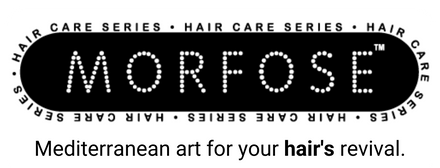How to Make a Smooth Transition to Natural Hair
Posted by MORFOSE COSMETICS

How to Make a Smooth Transition to Natural Hair
Natural hair has become a popular trend in recent years. However, transitioning from chemically treated hair to natural hair requires patience and proper care. In this article, we will explore the different aspects of making a smooth transition to natural hair, from understanding natural hair to managing two different hair textures.
Understanding the Transition to Natural Hair
Transitioning to natural hair is a journey that requires patience, commitment, and a willingness to embrace your unique hair texture. Natural hair has become increasingly popular in recent years as more people seek to break free from the societal norms of straight hair. If you are considering transitioning to natural hair, it is important to understand what it means and how to do it properly.
What is Natural Hair?
Natural hair refers to hair that has not been chemically altered through relaxers, texturizers, or straightening agents. Natural hair is characterized by its unique texture, which ranges from tightly coiled to loose waves. It is important to note that natural hair is not just a hairstyle, but a way of embracing your cultural identity and heritage.
Reasons for Transitioning
Many people choose to transition to natural hair for various reasons. Some may be tired of the maintenance required for chemically treated hair, while others may want to embrace their natural hair texture. Some may also be concerned about the potential health risks associated with chemical treatments. Whatever the reason may be, understanding your motivation will keep you on track during the transition process.
The Big Chop vs. Gradual Transition
The two main ways to transition to natural hair are the big chop and gradual transition. The big chop involves cutting off all the chemically treated hair at once, leaving only the natural hair. This can be a liberating experience for some, as it symbolizes a fresh start and a commitment to embracing one's natural hair texture.
However, the big chop can also be scary for some people, especially if they have been used to having long hair. A gradual transition may be a better option for those who want to ease into their natural hair. This involves gradually trimming the chemically treated hair as the natural hair grows out. This method requires more patience, but it can also be less drastic and more manageable for some.
Regardless of which method you choose, understand that the transition process will take time. Natural hair requires a different kind of care and attention than chemically treated hair, and it may take some time to figure out what works best for your hair type and texture.
Caring for Natural Hair
One of the most important aspects of transitioning to natural hair is learning how to care for it properly. Natural hair requires moisture, so it is important to use products that hydrate and nourish your hair. This may include using leave-in conditioners, oils, and deep conditioning treatments on a regular basis.
You may also need to adjust your styling routine to accommodate your natural hair texture. This may mean using different tools and techniques, such as finger detangling or using a diffuser to dry your hair.
Finally, it is important to embrace your natural hair texture and celebrate its uniqueness. Natural hair is beautiful in all its forms, and learning to love and care for your hair will not only improve its health, but also boost your confidence and self-esteem.
Preparing for the Transition
Transitioning to natural hair is an exciting journey, but it's important to take the necessary steps to ensure a successful transition. Here are some additional tips to help you prepare:
Assessing Your Hair's Health
Before transitioning to natural hair, it's important to assess your hair's health. If your hair is damaged from chemical treatments, it may need some tender loving care before you can start the transition process. Deep conditioning treatments, protein treatments, and a trim can help get your hair healthy before making the transition.
It's also important to consider your hair's texture and porosity. Understanding your hair's unique characteristics can help you choose the right products and techniques to care for your hair during the transition.
Consulting with a hair care professional, such as a trichologist or natural hair stylist, can also provide valuable insight into your hair's health and needs.
Setting Realistic Expectations
It's important to set realistic expectations before transitioning to natural hair. Natural hair requires a different level of care than chemically treated hair. It may take some time to find a hair care routine that works for you, and you may experience some setbacks and frustrations. However, with patience and determination, you can achieve healthy and beautiful natural hair.
During the transition process, you may experience some breakage or shedding as your hair adjusts to the new growth pattern. This is normal and can be minimized with proper care and maintenance.
It's also important to remember that everyone's natural hair journey is unique. Comparing your hair to others or expecting your hair to look a certain way can lead to disappointment and frustration.
Building a Support System
Transitioning to natural hair can be a challenging journey, and having a support system can make all the difference. Joining a natural hair community, seeking advice from friends and family, and finding a hair care professional who specializes in natural hair can provide helpful guidance and encouragement throughout the process.
Attending natural hair events and workshops can also be a great way to connect with others who are on a similar journey. These events often feature expert speakers, product demonstrations, and networking opportunities.
Remember, transitioning to natural hair is a personal choice and should be done at your own pace. With the right preparation, mindset, and support system, you can achieve healthy and beautiful natural hair.
Creating a Hair Care Regimen
Maintaining healthy natural hair requires effort and consistency. Creating a hair care regimen that works for you can help you achieve your hair goals. Here are some tips to help you get started.
Choosing the Right Products
Choosing the right products is essential for maintaining healthy natural hair. There are so many products on the market, and it can be overwhelming to know which ones to choose. Look for products that nourish and hydrate your hair, such as natural oils, shea butter, and aloe vera. Avoid products that contain harsh chemicals and sulfates, which can strip your hair of its natural oils.
When choosing products, consider your hair type. If you have dry hair, look for products that provide extra moisture. If you have oily hair, look for products that are lightweight and won't weigh your hair down.
Establishing a Wash Routine
Establishing a wash routine is crucial for maintaining healthy natural hair. You don't want to wash your hair too frequently, as this can dry out your hair. Depending on your hair type, washing your hair every 1-2 weeks may be sufficient.
When washing your hair, use lukewarm water and a sulfate-free shampoo. Sulfates can be harsh on your hair and strip it of its natural oils. Follow up with a conditioner to help detangle your hair and add moisture. Deep conditioning your hair regularly can also help keep it healthy and hydrated.
Moisturizing and Sealing Techniques
Moisture is essential for maintaining healthy natural hair. Without enough moisture, your hair can become dry, brittle, and prone to breakage. Look for leave-in conditioners, moisturizing sprays, and oils that will moisturize your hair and seal in the moisture.
Experiment with different products to find what works best for your hair type. For example, if you have low porosity hair, you may need to use lighter products that won't weigh your hair down. If you have high porosity hair, you may need to use heavier products that can penetrate your hair shaft and provide extra moisture.
Protective Styling Options
Protective styles can help minimize damage to your hair during the transition process. Braids, twists, and buns are all great options for protective styles. However, be careful not to make protective styles too tight, as this can cause breakage.
When wearing protective styles, be sure to moisturize your hair and scalp regularly. You can use a spray bottle to mist your hair with water and a leave-in conditioner. You can also use oils to help seal in the moisture.
Remember, creating a hair care regimen takes time and patience. You may need to experiment with different products and techniques to find what works best for your hair. With consistency and dedication, you can achieve healthy, beautiful natural hair.
Managing Two Different Textures
Transitioning to natural hair can be an exciting journey, but it can also come with its own set of challenges. One of the biggest challenges is managing two different hair textures. The key to successfully managing two textures is to be patient and gentle with your hair. Here are some tips to help you manage your hair with care.
Detangling with Care
Detangling can be a challenge when transitioning to natural hair. It's important to detangle your hair with care to prevent breakage. To do this, use a wide-tooth comb or detangling brush and start at the ends of your hair. Slowly work your way up to the roots, gently detangling any knots or tangles along the way. Be patient and take your time, as rushing through the process can cause breakage and damage to your hair.
Additionally, it's important to use a good quality leave-in conditioner or detangling spray to help soften your hair and make it easier to detangle. This will also help to minimize breakage and damage to your hair.
Minimizing Breakage
Breakage can occur when transitioning to natural hair, especially when dealing with two different hair textures. To minimize breakage, it's important to avoid using heat tools on your hair, as this can cause damage and breakage. Instead, opt for air-drying your hair or using a diffuser attachment on your blow dryer.
It's also important to be gentle when handling your hair. Avoid rough towel-drying and instead use a soft t-shirt or microfiber towel to gently squeeze out excess water. Additionally, protective styles can help prevent breakage by minimizing manipulation of your hair. Braids, twists, and buns are all great protective styles to try.
Styling Tips for Blending Textures
Styling your hair when dealing with two different hair textures can be a challenge, but it's not impossible. Experiment with different hairstyles and products to find what works best for you. Braid-outs, twist-outs, and bantu knots are all great styles for blending textures.
When styling your hair, it's important to use products that will help define your curls and minimize frizz. Look for products that are specifically designed for curly or natural hair, and avoid products that contain harsh chemicals or alcohol, as these can dry out your hair and cause damage.
Remember, managing two different hair textures takes time and patience. Be gentle with your hair, and don't be afraid to seek out advice from other natural hair enthusiasts or professionals. With the right care and attention, you can successfully manage two textures and achieve healthy, beautiful natural hair.
Conclusion
Transitioning to natural hair can be a rewarding experience, but it requires patience, proper care, and time. Understanding your hair's needs, building a support system, and experimenting with different products and styles can help you achieve healthy and beautiful natural hair. Remember to be gentle with your hair, be patient with yourself, and enjoy the journey!


